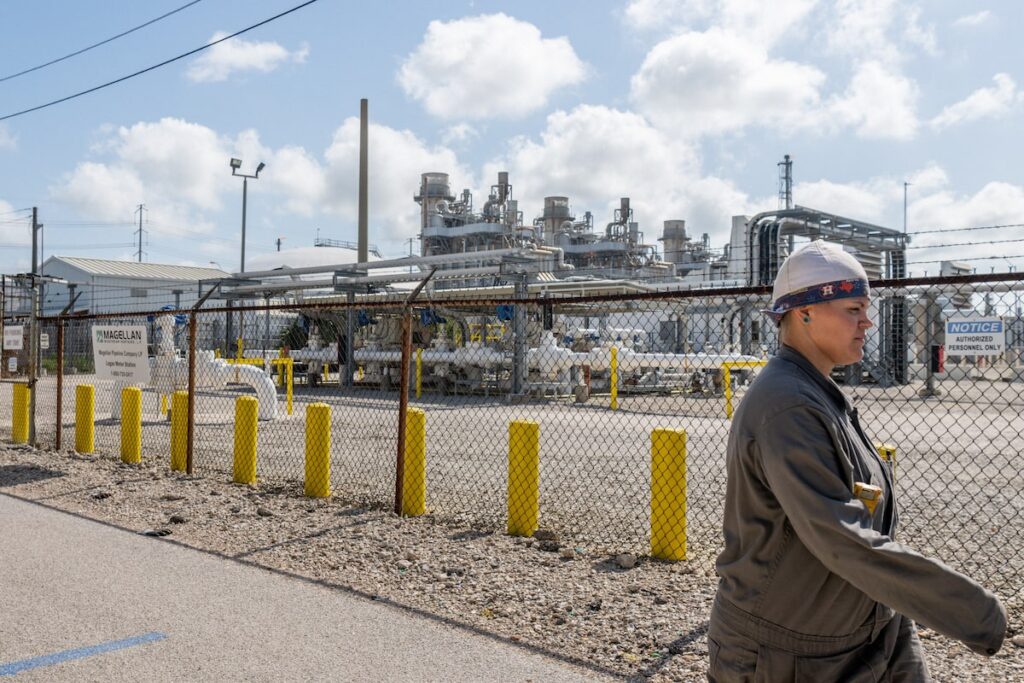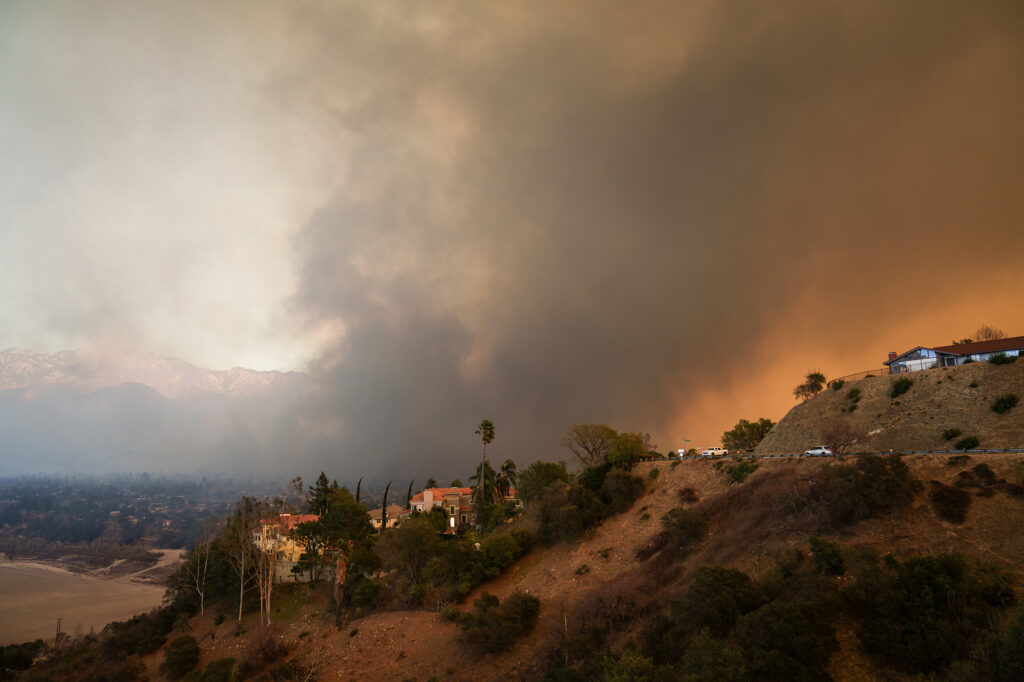]
A worker exits the Marathon Galveston Bay Refinery in Texas City, Tex., on May 10, 2022. Marathon recently completed a project to increase its capacity to handle heavy Canadian crude at the Texas City refinery.Brandon Bell/Getty Images North America
About 70 kilometres down the Interstate 45 from Houston sprawls a site of massive pipes, hulking white storage tanks and towers belching flares and steam – the largest oil refinery in the United States.
Marathon Petroleum Corp.’s MPC-N Texas City refinery, constructed in 1931, has a capacity of 631,000 barrels per day. About 1,550 people work here full-time, processing crude oil into gasoline, distillates, natural gas liquids, petrochemicals, heavy fuel oil and propane.
This area of Galveston County, separated from the Gulf of Mexico by its namesake island, is thick with massive refineries that rely on heavy Canadian crude to fuel their operations.
But that supply is the target of president-elect Donald Trump, who has pledged to slap a 25-per-cent tariff on all U.S. imports from Canada, including oil and gas. The details of exactly how a tariff program would work – whether the levy would be as high as 25 per cent and who would pay it – are still up in the air. But industry on both sides of the border are preparing for the worst as Jan. 20 fast approaches, when Mr. Trump will be sworn in as 47th president of the United States.
Already investors are souring on the U.S. oil refining sector, citing forecasts for softer fuel demand and worries about tariffs. Shares of Valero Energy Corp. VLO-N slipped more than 6 per cent in 2024, while rival Phillips 66 Co. PSX-N fell more than 15 per cent during that period. And shares of Marathon closed 2024 down 8 per cent for the year.
Marathon recently completed a project to increase its capacity to handle heavy Canadian crude at its Texas City refinery so it could take advantage of the discounted price from its northern neighbours. It’s indicative of how imports from Canada have become increasingly important to refineries on the Gulf Coast and in the American Midwest; those two regions combined receive three-quarters of Canada’s crude oil exports.
Many U.S. lawmakers unaware of how Trump tariffs would hurt American economy, trade, Foreign Affairs Minister Joly says
About 40 per cent of U.S. refineries are specifically tooled for heavy crude – the kind produced in Canada, predominantly from the oil sands. In 2023, Canadian crude accounted for about 24 per cent of U.S. refinery output, according to the U.S. Energy Information Administration. That’s about 3.9 million barrels a day – an increase from 17 per cent in 2013.
The U.S. imports more crude from Canada than from any other country. As production grows in both countries, they have become increasingly joined at the hip.
So while the U.S. energy sector is by and large thrilled by Mr. Trump’s promise to “Drill, baby, drill!” and increase domestic oil and gas production, American Petroleum Institute president and chief executive officer Mike Sommers is also a realist.
Voters “sent a clear message” during the election that they want Congress to focus on resource production in the country, rather than depending on foreign imports, he told reporters this week. Yet he acknowledges that the free flow of Canadian and Mexican oil to U.S. refineries has played an outsized role in keeping domestic fuel prices low.
“We rely on imports of those crude products from other parts of the world that have heavier quality crude, like Canada,” Mr. Sommers said.

U.S.: Outside oil and gas, Uncle Sam enjoys
a significant trade surplus with Canada
U.S. trade balance on goods and services with Canada: Total vs. oil and gas
(All figures in billions of U.S. dollars)
Balance excl.
oil and gas
Total balance
on goods
and services
the globe and mail, sourceNBC Economics and Strategy
(data via U.S. Census Bureau)

U.S.: Outside oil and gas, Uncle Sam enjoys
a significant trade surplus with Canada
U.S. trade balance on goods and services with Canada: Total vs. oil and gas
(All figures in billions of U.S. dollars)
Balance excl.
oil and gas
Total balance
on goods
and services
the globe and mail, sourceNBC Economics and Strategy
(data via U.S. Census Bureau)

U.S.: Outside oil and gas, Uncle Sam enjoys a significant trade surplus with Canada
U.S. trade balance on goods and services with Canada: Total vs. oil and gas
(All figures in billions of U.S. dollars)
Balance excl.
oil and gas
Total balance
on goods
and services
the globe and mail, sourceNBC Economics and Strategy (data via U.S. Census Bureau)
And while he’s confident that the Trump administration “understands the importance of that kind of trade,” Mr. Sommers said his industry trade association will work with the new president to ensure Canada is not forgotten as the government hashes out trade policy.
“We want to make sure that we’re able to continue to have free trade with our partners, to ensure that American consumers continue to benefit from low prices at the pump and in power markets,” he said.
Chet Thompson, president of the American Fuel and Petrochemical Manufacturers, another industry group, has also stressed how much U.S. refiners rely on crude from Canada and Mexico. “We would hope any future tariffs would exclude these critical feedstocks and refined products,” he said in a recent statement.
The U.S.-Canadian relationship is by far the largest bilateral oil trading relationship in the world, bound by a complex of pipelines, oil terminals and refineries thanks to decades of stable and friendly relations both sides of the 49th parallel.
In a recent research paper for the Canadian Global Affairs Institute, oil analysts Rory Johnston and Joe Calnan underscored that mutual dependence between the Canadian and U.S. energy sectors.
“I think it should be underlined how unprecedented it is to have these extremely severe trade moves happen between two very friendly countries on such an enormous volume of trade,” Mr. Calnan said in an interview this week.
The two sectors have become so intertwined, Mr. Johnston said, that it would be almost impossible to find enough supply from elsewhere to replace Canadian heavy crude in the Midwest.
Stopping oil exports to the U.S. is the nuclear option – and it risks harming us more than them
“Even if you could, you couldn’t get it from the Gulf Coast or any coast into the Midwest, because there’s not enough pipeline infrastructure,” he added. And overhauling refineries so they could process lighter, U.S.-produced oil would render obsolete tens of billions of dollars worth of equipment used specifically for heavy oil – what company would agree to that?
As Mr. Trump’s inauguration draws ever-closer, Canadian industry is getting prepared, and federal and provincial politicians are leaning on all of their U.S. connections to try and quell the tariff threat.
Alberta Premier Danielle Smith headed to Florida last weekend to lobby Mr. Trump at his resort, and this week Prime Minister Justin Trudeau gathered with most of Canada’s premiers in Ottawa to discuss retaliation plans and opportunities to deepen partnerships with the United States.
In addition, Energy Minister Jonathan Wilkinson went to Washington this week and proposed that Canada and the U.S. form an energy and minerals alliance to expedite the export of petroleum and critical minerals to U.S. customers.
Canada is trying to play to some of Mr. Trump’s stated wishes, Mr. Wilkinson told The Globe, such as reducing the United States’ reliance on authoritarian regimes such as Russia and China, and enhancing energy security.
It’s not the U.S. industry that needs convincing about the economic pain tariffs will cause on both sides of the border, he said. It’s the incoming administration, which is so far holding its cards close to its chest.
On the business side, five of Canada’s largest energy-focused industry associations have formed a joint working group to try to prevent tariffs in the first place, and come up with ways to mitigate the effect on the sector should Mr. Trump follow through with his threat.
But individual companies lament that there is not much they can do.
Canadian Natural Resources Ltd. CNQ-T president Scott Stauth recently told an investor call that it’s hard to give a definitive answer on how tariffs will affect the oil giant until they come into play. The key, he said, is flexible operations.
“We have built ourselves a resilient business here that’s sustainable to take the ups and downs. We saw those ups and downs happen during COVID, and if we happen to see that happen this coming year here, then we’ll be prepared,” he said.
Adam Waterous, CEO of Waterous Energy Fund, believes that Canada wouldn’t be in the crosshairs of a trade war if the federal government had done more to support the Energy East and Northern Gateway pipeline projects.
“We’d be redirecting our oil away from the United States to international markets,” he said. “But Donald Trump has us over an oil barrel because he knows we have no alternatives.”
He said Ottawa must push for peace as quickly as possible to avoid huge damage to Canada’s oil sector.
Veteran U.S. oil investment banker Thomas Wilson, at Energy Investments LLC, has seen tariff threats and oil market upheaval before. He said in an interview that consumers will end up eating a chunk of the increased gasoline prices that are the likely outcome of tariffs, but he’s not convinced oil and gas movement between the countries will grind to a halt.
“There’s going to be a lot of sword rattling, there’s going to be a lot of talk,” he said. “But as far as the net effect of it, I don’t see that it will start or stop the ball from rolling.”
And the refineries in Texas? They’re going to continue pumping out product, tariffs or no tariffs, he said.
With a report from Reuters








